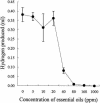Effects of essential oils on ruminal microorganisms and their protein metabolism
- PMID: 12902303
- PMCID: PMC169102
- DOI: 10.1128/AEM.69.8.5011-5014.2003
Effects of essential oils on ruminal microorganisms and their protein metabolism
Abstract
A commercial blend of essential oil (EO) compounds was added to a grass, maize silage, and concentrate diet fed to dairy cattle in order to determine their influence on protein metabolism by ruminal microorganisms. EO inhibited (P < 0.05) the rate of deamination of amino acids. Pure-culture studies indicated that the species most sensitive to EO were ammonia-hyperproducing bacteria and anaerobic fungi.
Figures



Similar articles
-
Nutrient digestibility, ruminal fermentation, and milk yield in dairy cows fed a blend of essential oils and amylase.J Dairy Sci. 2018 Nov;101(11):9815-9826. doi: 10.3168/jds.2018-14789. Epub 2018 Aug 23. J Dairy Sci. 2018. PMID: 30146293
-
Effect of essential oils on ruminal fermentation and lactation performance of dairy cows.J Dairy Sci. 2013;96(12):7892-903. doi: 10.3168/jds.2013-7128. Epub 2013 Oct 11. J Dairy Sci. 2013. PMID: 24119814 Clinical Trial.
-
Effects of essential oils on milk production, milk composition, and rumen microbiota in Chios dairy ewes.J Dairy Sci. 2011 Nov;94(11):5569-77. doi: 10.3168/jds.2010-4096. J Dairy Sci. 2011. PMID: 22032380
-
Invited review: Essential oils as modifiers of rumen microbial fermentation.J Dairy Sci. 2007 Jun;90(6):2580-95. doi: 10.3168/jds.2006-644. J Dairy Sci. 2007. PMID: 17517698 Review.
-
Essential oil for the control of fungi, bacteria, yeasts and viruses in food: an overview.Crit Rev Food Sci Nutr. 2023;63(27):8960-8974. doi: 10.1080/10408398.2022.2062588. Epub 2022 Apr 13. Crit Rev Food Sci Nutr. 2023. PMID: 35416734 Review.
Cited by
-
The effect of ajowan (Carum copticum L.) essential oils on eukaryotic ruminal microorganisms of Mehraban sheep.Iran J Microbiol. 2013 Dec;5(4):418-21. Iran J Microbiol. 2013. PMID: 25848515 Free PMC article.
-
Feedlot diets containing different starch levels and additives change the cecal proteome involved in cattle's energy metabolism and inflammatory response.Sci Rep. 2022 Apr 5;12(1):5691. doi: 10.1038/s41598-022-09715-7. Sci Rep. 2022. PMID: 35383279 Free PMC article.
-
Dietary Bioactive Lipid Compounds Rich in Menthol Alter Interactions Among Members of Ruminal Microbiota in Sheep.Front Microbiol. 2019 Sep 4;10:2038. doi: 10.3389/fmicb.2019.02038. eCollection 2019. Front Microbiol. 2019. PMID: 31551974 Free PMC article.
-
Gut microbiome colonization and development in neonatal ruminants: Strategies, prospects, and opportunities.Anim Nutr. 2021 Sep;7(3):883-895. doi: 10.1016/j.aninu.2021.03.004. Epub 2021 May 29. Anim Nutr. 2021. PMID: 34632119 Free PMC article. Review.
-
The Effects of a Blend of Essential Oils in the Milk of Suckling Calves on Performance, Immune and Antioxidant Systems, and Intestinal Microbiota.Animals (Basel). 2024 Dec 10;14(24):3555. doi: 10.3390/ani14243555. Animals (Basel). 2024. PMID: 39765459 Free PMC article.
References
-
- Eschenlauer, S. C. P., N. McKain, N. D. Walker, N. R. McEwan, C. J. Newbold, and R. J. Wallace. 2002. Ammonia production by rumen microorganisms and enumeration, isolation, and characterization of bacteria capable of growth on peptides and amino acids from the sheep rumen. Appl. Environ. Microbiol. 68:4925-4931. - PMC - PubMed
Publication types
MeSH terms
Substances
LinkOut - more resources
Full Text Sources
Molecular Biology Databases

